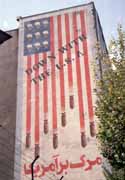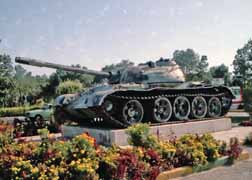Emissary of The Great Satan
This trip almost wasn't. Although I booked six months ago and have held an air ticket Brussels to Teheran since April, I still had no visa for Iran. Tourist visas are not issued to Americans (or U.K. residents) except for tour groups and even then only after permission from the Iranian foreign ministry. On September 10th, still no permission. The next day, things happened. Amazingly, two weeks later the visa is authorized. Departure is two days later.
The first leg is the flight to Newark. On September 18th I had flown to New York and had heeded the warnings about checking in extra early to allow for security delays -- I got to the airport 90 minutes before departure, which turned out to be 88 minutes too soon. The airports were deserted, and the flights were empty. This time, I reduced the lead time to 50 minutes, and I was the last one to check in. This flight is about 40% full.
The next leg is from Newark to Brussels. It is a wide-body plane. There are two people in business class and 6 in "premium coach" (including me). I overhear that the passenger count is 56. It is one of the new 767's with person video monitors for all seats. Instead of craning to see a tiny distant screen, I am able to spend the flight flipping around a selection of terrible movies, insipid sitcoms, and shopping channels. (Just like cable TV, except you can also play Space Invaders.) On the info channel I learn that the in-flight menu is the creation of Continental's Congress of Chefs. I can envision that august body being called into session to ponder the weighty issue: "beef or chicken?"
I pick up the Wall Street Journal. How timely: an article on a terrorist trade show in Teheran. And the International Herald Tribune reports that after a two-week hiatus they are back to chanting "Death to America," a twenty-year tradition.
The underworked flight attendant proffers the latest Congress of Chefs creation. While ingesting it I realize how quickly one gets spoiled. There are no automatic upgrades on international flights. No glassware. No linen. And all the the brouhaha over plastic knives is an academic issue -- in coach, plastic knives is all one ever gets.
We arrive in Brussels at 8 a.m. local time. The airport is real quiet. I mean dead. The lounge is pretty crummy. It is ignobly named the "Common Lounge" and is utilized as a business class lounge by various Third World airlines, including Cubana. Maybe it should be renamed the "Fidel Says Capitalist Pigs Should Suffer Lounge."
The next segment is a British Air flight to London. (This backtracking route costs half as much as a direct flight from either Brussels or London.) The front half of the plane is empty, and the back half is packed. I ask why, and am informed that the front half is business class. I check carefully for differences: they have doilies on the headrests. two extra inches of legroom, but the same miserable six-across spacing. There is a symbolic divider separating what are really two classes of steerage.
At Heathrow, the lounge is much nicer. It is well stocked with newspapers, so I get to read half a dozen different tabloid takes on the current flap with the Royals, plus a more sober version in the Times.
The flight to Teheran is delayed two hours. In the British Air jetway Virgin has bought the final billboard, which says simply: "Hi there. Enjoy your overpriced flight."
It's a 4 and 1/2 hour flight to Baku, the capital of Azerbaijan on the Caspian. (I visited there when it was part of the Soviet Union.) Most people get off. I take full advantage of the bar service since it's going to be a dry two weeks. Alcohol is strictly forbidden in The Islamic Republic of Iran.
It turns out that the author of my just-published guidebook to Iran is on the plane, holding court at the rear. I get my book autographed and a bit of advice. I later learn that our tour leader was seated one row ahead of the author and was silently wishing that the know-it-all behind her would be quiet so she could get some sleep (not realizing that she really did know it all).
The final segment is an hour. Women in un-Islamic attire are not admitted into Iran, so as we approach Teheran, the shmatas and the head scarves come out.
The immigration, desk workers are all women. They look like beadles, but are friendly enough. Above the arrival hall, a giant portrait of Ayatollah Khomeini is glares down. At the bank, I change $100 and get back a big brick of Ayatollah bucks. The highest denomination bill printed is only worth $1.25. I abandon the motion of carrying a wallet.
I wade past the taxi touts and head to the official taxi kiosk, where a cab into the city costs $3.50, which the locals consider to be an enormous rip-off. It's 3:30 AM, and the price is just fine with me. The cabdriver asks where I am from, then tunes the radio to the Voice of America.
The tourism industry in Iran was never booming, and now it has completely collapsed. The hotel is almost empty, but they are trying to make it up by raising their rates for the remaining guests. They want $40 for a single. I talk them down to $35, but am first sworn to secrecy. (I have not broken my vow -- I will not disclose the hotel name.) At breakfast, there is a Japanese tour group. All covered up, they remind me of Little Red Riding Hood, only all in black.
I stroll out of the hotel. I stop in a small, nondescript shop to buy some batteries. The owner asks me where I am from. He breaks into a broad smile and booms, "Welcome to Iran!" He is even more pleased to learn that I am a tourist. This warm greeting is the usual reaction throughout the trip.
I wander the streets taking in the sights and sounds. The city is pretty ugly. Billboards and murals of the deceased Ayatollah Khomeini and current Supreme Leader Ayatollah Khamenei are ubiquitous. The air pollution is supposed to be terrible, but it is clear today. Traffic is utterly insane, complete chaos combined with gridlock, including people driving the wrong way in oncoming lanes. (It's even worse than Cairo.) The buses are packed -- men in front, women in back (as required by law). Depending how you count, There are eight to sixteen million people in the metro area, although I can't imagine that pedestrians have a very long life span. My guidebook puts it well:
Regard zebra crossings as merely road surface decoration. Pedestrians take their life into their own hands crossing the road, and the sight of their terror heart stricken faces forms the chief entertainment for motorists. If a driver flashes his lights it does not mean it is safe to cross; your presence is being acknowledged, but not necessarily your continued existence on this earth. On the other hand, having started to cross, do not turn tail or break into a run; both actions constitute a personal challenge to the driver to continue the pursuit.
Just as Havana is a rolling museum of 1950 American cars, Teheran is a showcase of 1970's automotive styling. The cars are missing all of their trim because they have been in countless accidents. The sheet metal is straightened out, but the trim cannot be replaced.
Despite the very warm weather, most men wear long-sleeves although there are a number of half-sleeves. Businessmen wear suits but no neckties, which are considered a mark of western cultural imperialism. All women must be covered. Some women just wear scarves while others are clutching their chadors tightly at the chin. Those going for the really slutty look are revealing their forelocks. There is not a single Westerner to be seen, but I don't seem to attract any stares. Wearing a somber shirt, long sleeves, loose slacks, and unshaven I fit right in.
The movie theaters are plastered with posters for hot action movies with hot action babes. They are all bundled up, but you can tell they are hot because they are wearing cool sunglasses.
 | 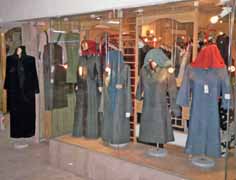
|
At the Carpet Museum, I am the ONLY visitor. My $3 (foreigner price) admission has to support its staff of about 40. Sort of boring. Next stop is the National Jewels Museum, formerly the Crown Jewels. Bejeweled crowns, thrones, swords, and piles of unset stones plus the expected assortment of gigantic necklaces, pendants, rings, earrings, etc. going back several centuries. Exceptionally vulgar, but worthwhile.
While looking for another museum, I ask one of the ubiquitous soldiers (slouching teenagers with Kalashnikovs) for directions. He speaks no English, but cheerfully takes me inside a government ministry where someone else promptly appears to render assistance. He leads me through a long corridor. The building is plastered with revolutionary slogans, giant Ayatollahs and big "no photo" signs. I can see why they don't want any pictures: the offices are either vacant or full of guys sitting around chatting and smoking.
Back at the hotel, I enjoy a "Parsi-Cola" from the mini-bar. (There is also Coke, "red" flavored Fanta, and "alcools-free" beer.) I turn on the TV. There are five government channels; no satellite or cable TV allowed. The six o'clock prayers are on all five channels, although accompanied by different videos. Afterwards, the news. You don't need to know Farsi to figure it out. The weather girl is all bundled up with sleeves down to her knuckles. Then, a report on women's sports. I will leave it to your imagination of what that looks like. I wonder whether in competition both sides wear black? (The morning women's exercise show consists of standing and stretching out arms and turning wrists.) Finally, the entertaining programming: Patti and Selma Bouvier would be pleased to know that McGuyver has been dubbed into Farsi.
The next day I move to the joining hotel for the tour group. It is not, as advertised, "centrally located," but it is across the street from the American Den Of Espionage f/k/a the American Embassy. In addition to the "Down With U.S.A." sign at the entrance, the walls are decorated with anti-American murals and quotations from Ayatollah Khomeini about the Great Satan. Photographs are forbidden. (The anti-American propaganda is only for internal consumption; they know it is bad for the country's image.)
 | 
|
I am off to the Universal Exposition of Sacred Culture and Defense, which I had read about on the plane. The occasion is the anniversary of the 21st anniversary of the start of the Iran/Iraq war. A few months after the overthrow of the Shah the country was in chaos and the military had disintegrated. Saddam Hussein invaded, expecting to be in Teheran in a matter of days. Defeat was averted by fanatical volunteers who defended and then attacked in human wave assaults and suicide squads. While the war dragged on for 8 years of stalemate, the situation enabled the radicals to consolidate their position and take control over all aspects of the government, which they still hold firmly in their grip. The mullahs are supported by only about 15% of the population but they aren't letting go. Despite landslide electoral majorities for reform, there has been very little change. The purpose of the Exposition is to recall the glorious days of sacrifice and rekindle the revolutionary fervor of a disaffected populace.
It is the size of a county fair. The first area I visit is a recreation of the war scene. It looks very much like Russian "defending the homeland" propaganda during WWII. There are numerous displays, life size dioramas, and recreated battlefields. Lots of blown up bodies, bombed-out schools, and mothers sending their sons to the front, then returning on the homefront knitting. There is no shortage of reminders that Iraq was being supported by the U.S., U.K, France, and Russia, and no hint that Iran was being supplied by Israel, which wanted to keep the war going, and by South Africa in arms for oil deals.)
In the battlefield section, there are trenches, barbed wire, blown up vehicles, and piles of rubble. Soldiers in bunkers pray and write home (on Ayatollah stationery), while officers plot strategy. All the while, loudspeakers are providing sound effects of explosions and screams. A medical tent shows grisly videos of battlefield surgery.
After the battlefield, full-size wax figures of the peace parley depict Saddam at a conference table of banging his fist before assembled representatives of the world powers. Then the "victory" celebrations. Finally, one passes through a simulated veterans' hospital and a graveyard.
The next area focuses the "Liberation of Palestine," where Hezbollah and the other terrorist groups have their booths. Posters show Israelis as Nazis, the Jewish star as a swastika, and Jews as baby-killers. Pre-1948 Palestine is depicted as paradise stolen. (Their explanation of the outcome of the 1948 drive to eliminate Israel: the poorly armed and unorganized Arabs had no chance against the mighty Zionist war machine.) It's the same propaganda The Iranians have been fed a daily diet of this propanganda for the past twenty years and are bored with it; I am about the only visitor.
Considerably more popular is the display of military hardware of every sort. Tanks, planes, boats, missiles, new, old, western and soviet, including a downed Iraqi jet. A safe bet when entertaining the youngsters: boys love to crawl on tanks.
I have been photographing the entire scene. Everyone around me has been eager to get into the picture and pose. That is until I take a photo of mannequins astride a motorcycle demonstrating an assassination technique. Immediately three guys come up and ask my nationality. Then they ask for my passport. A bit of background: the guidebooks, signs in the hotel, and the hotel desk clerks all warn of a scam in which tourists are accosted by self-described secret police who want to see passports and money with the goal of relieving them of the latter. The hotel manager tells me not to carry my passport with me and, if stopped, to say that it is at the hotel. I have done just that. There is a communication problem because they only know a few words of English. They tell me they are "hidden police." I demand to see uniformed police.
They take me to an area behind the exhibit and won't let me leave. They make some calls, but won't let me call the hotel. They are very nice, offering me tea and cookies, but very insistent that I stay. After about half an hour, three more guys show up with radios and ear pieces and escort me to a nice new car which they had driven up to the exhibition area. These guys don't speak English either.
We drive about 20 minutes to a high-security compound with military guards. (My guide, who had worked for military intelligence, later identified it from my description as the counter-espionage section of military intelligence.) They put me in an interrogation room with a big bank of spotlights and tell me to wait. I don't want to be abandoned, so I insist one of them stay with me. He is friendly, but his limited English limits conversation to questions like "How long Iran?" and "Iran good?"
After a while, they bring me to the phone. They had found someone who speaks English, who tells me that although photography was permitted throughout the exhibition, photos were forbidden in that particular exhibit. I would have to give them my film but they would develop it and return the rest of the pictures. He says that there is no problem and that I could go back to the hotel. However, my captors didn't seem to get that same message from him, since they weren't taking me anywhere. (They are checking out my story.) They want to put me back in the interrogation room but I insist on hanging around with them. They are reading the paper and asking me about Afghanistan (in Farsi, of course). Eventually, they get another call and off we go. The rush hour traffic parts like the Red Sea when they turn on the bullhorn demanding the other vehicles give way. Back at the hotel, they shake my hand and wish me well.
All in all, the escapade took about 2 1/2 hours, about 1/2 hour of which was my free taxi ride home. That's why they call it adventure travel.
The rest of the group arrives late Sunday night. They are supposed to be 19 others, but there are 7 cancellations and 4 no shows. We are 9: besides me, there are 3 New Zealanders and 4 Brits, 1 Austrian (married to a Brit), plus our English tour leader and our guide. He learned English by listening to the BBC, including its "received pronunciation"; if you closed your eyes, you would swear that you were listening to a newsreader. The Kiwis have brought an "emergency kit": an American flag and a cigarette lighter.
We are supposed to leave for Shiraz, but our flight has been rescheduled to that evening. It is Ali's (son-in-law of Mohammed) birthday, a public holiday, so everything is shut tight and we have the day to kill. I am thinking about going back to the Sacred Defense Exhibition and recapturing my lost shots, but the guide thinks that is a terrible idea since the spycatchers might not be nearly so nice the second time. (He also said that if they would have been serious the first time I would have been blindfolded for the car ride.) So we just hang around the hotel in the morning.
In the afternoon we waste time collectively. We go to a shrine, the tomb of a son of an Iman. The Shiites, the Muslim sect which dominates Iran, revere the 12 Imans, descendants of Mohammed through Ali. This shrine is for someone whose only claim to fame is a father with a good job, but it's holy nonetheless. Because it's a holiday, the faithful are pouring in. While we are waiting a middle-aged woman in a black chador comes up and asks the guide our nationality. "English," he replies. She then animatedly and vociferously berates him. After she leaves, he tells us what she said: "Tell them when they go back to England they should take with them the mullahs they put into power. We have had enough. We are fed up with them." There is a pervasive belief, he explains, that the English have been pulling the strings of power in Iran for the past 100 years. To me, the incident speaks volumes about the current political situation. Here is a woman in the most conservative of dress at a religious shrine railing against the theocracy.
We are in the northern suburbs of Tehran, the most prosperous, and decadent (westernized) part of the city and country. The ambiance is so licentious that some women have on scarves that only cover half their heads. Our guide points out the "Super Star" restaurant (looks like a Carls Jr. logo) with concrete arches. It was built as the first McDonald's in Iran but was only open for one day, after which the radicals stormed, sacked and burned it.
At the airport, there is fairly stringent security. (I guess they are vigilant against Zionist hijackers.) In the coffee shop the instant coffee packets feature an American flag and a bald eagle -- must be Great Satan brand. While waiting for our flight to be called, I meet a computer programmer. He asks me in fluent English about the 9/11 attacks. He is genuinely puzzled. He does not accept the government explanation that it is all a Zionist plot but still cannot accept that ordinary hijackers could defeat the stringent airport security and immigration restrictions in America. Because it is almost impossible for Iranians to get visas for the U.S., he figures it must be equally difficult for others.
Aboard our Iran Air flight, the stewardess dresses as you would expect except that she has gold braid on her cuffs. I decide that the hijab -- the Islamic dress code -- is not such a bad idea. Most people are not all that good looking. Better to cover up than to expose acres of unattractive flesh. And think of all they could accomplish if women didn't have to spend so much time fussing with their hair.
We arrive in Shiraz late at night. In the morning we set out for a day of sightseeing. The first stop is the shrine of a brother of the eighth Iman. Another relative with a good job. We have a local guide, who explains without a hint of incredulity that although the body was not discovered for 200 years, the corpse had not decayed.
 | 
|
Shiraz is renounced as a home of Persian poetry. We visit the tomb of Saadi, a famous poet, who had a string of bad luck before getting into the poetry business. He fled the Mongols, only to be captured by the Crusaders. He was ransomed by a rich merchant and married the daughter in gratitude. She proved to be a harridan. Saadi's famous and oft-quoted line is that it is hell on earth to be married to a bad woman. He ran away from her to Shiraz, where he took up rhyming. Our local guide, who has the demeanor and delivery of a drill sergeant, inflicts some of his verse on us. Then we visit the tomb of Hafez, the most famous poet of them all, where we endure another poetry drill.
We have the afternoon free. As I stroll around, two teenage boys on a motor scooter latch on to me. They have extremely limited English but no problem communicating. "I love America!" "I love you!" "Dinner at my house?" they shout.
Each night, the TV has 15 minutes of news in English. There is really only one story: Israeli oppression of the Palestinians and all corollaries and variations thereof. Iran opposes terrorism, and they believe that problem No. 1 is "state sponsored terrorism against the Palestinians." (This attempt to distract the populace from the government's domestic failings is transparent to every Iranian I meet.) There is also the religious angle. On Ali's birthday the newsreader extends "congratulations to all Muslims and especially our viewers." On a mourning day (one of many), this one for the anniversary of the death of a wife of an Iman, the broadcast opens with "condolences to all Muslims and especially our viewers." They have a rotating cast of stern-faced newsreaders, but the most popular is an American named Judy, who is slightly less dour than the rest. She married an Iranian and moved to Teheran. Sort of like Tokyo Rose.

The newspapers are also government controlled. There are a couple of English language papers. The biggest story one day in the Iran Daily is headlined "Israeli troops fire rubber bullets at demonstrators." A much smaller article nearby is "Bush gets ready to attack Afghanistan." There is also a piece about a crackdown in Teheran on shopkeepers who sell lingerie to single women or who serve women who are showing their hair or wearing makeup.
The Tehran Times doesn't have much news (but neither does the (Jacksonville) Times-Union), and it costs only 6?. In it, I read that Supreme Leader Khameni warns women against feminism and reminds them that their role in society has been prescribed by Allah. And a war veteran has at last achieved martyrdom. Martyrdom is a word in daily use. The war dead are all martyrs. Palestinians do not die, they achieve martyrdom. At dinner we wonder whether the chicken on our plate has also achieved martyrdom.
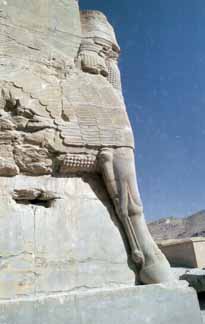 | 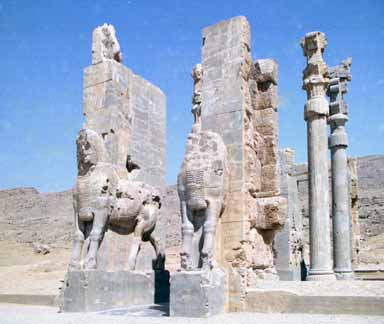
|
The next day we visit Persepolis, one of the highlights of the trip. It was a ceremonial palace complex sacked and burned by Alexander the Great around 330 BC, and thereafter abandoned. Not to be excavated until 1931, it is one of the world's great archaeological sites but, unlike most others, it is not crawling with tourists. There are only three buses in the parking lot. Most of the good stuff was taken to the Louvre, but there is still a lot of gargantuan statuary remaining. The area is not in an earthquake zone, so the columns have remained standing for 2500 years. After that, we visit the tombs of Darius and Xerxes.
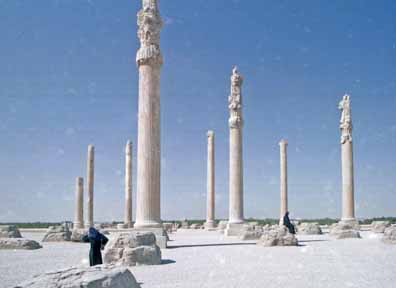 | 
|
The next day is a long day driving to Kerman. The countryside looks exactly like Utah. The road is good, but the speed limit is very low and strictly enforced. It takes all day to go 280 miles. In middle of the desert we suddenly encounter hundreds of black clad youths marching around carrying flags. There are Basiji ("volunteers") -- part boy scout and part Khomeini Youth. It is an effort to instill the revolutionary spirit in the next generation. There is also a girls' division. although I question whether marching around in the desert in the broiling sun while covered from head to toe in black works up anything more than a sweat.

We pass through pistachio country. The trees look like big bushes in the desert. We stop and buy some at a roadside stand. Fresh pistachios have red and yellow skins sort of like a fleshless peach, under which is the nut. The nut is closed, and the meat is moist. In processing, the skins are removed and the nut roasted to dry it out and force the shell open. From the dealer processed nuts are about $3 a kilo. Fresh from the farmers, they are about half that.
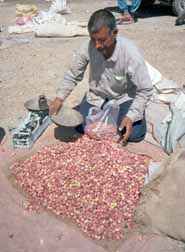
The point of driving to Kerman is so we can visit Bam, another highlight. Bam is an oasis on the ancient spice route. It is an adobe walled city surrounded by date groves. Its highly picturesque citadel and is another spot that ought to be crawling with tourists, but we pretty much have it to ourselves. Our visit comes at a price: this is my only Friday in Iran (I arrived late Friday night, will be leaving early Friday morning) and, by being at the citadel, I am missing my only opportunity for attending the weekly Death To America rally. [Note: Bam is nor more ? it was destroyed by an earthquake in 2003.]
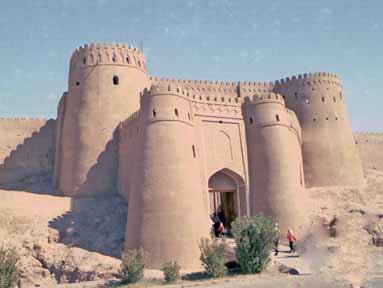 | 
|
Coming back from Bam, the highway check point is very strict. We are only about 200 miles from Afghanistan and this is the narcotics smuggling route. The police are actually disassembling cars in their inspections.
On the way back we stop in Mahan at the shrine of a Sufi mystic. In its museum is one of the few "authorized" portraits of Mohammed. It is imagined rather than drawn from life and looks a lot like Moses with a black beard. (Thanks to Charlton Heston, we KNOW what Moses looked like.) There is also an image of Mohammed as an 18-year-old which, to my infidel eyes, looks like a 14-year-old girl. And while I'm blaspheming, the official portrait of Hussein, grandson of Ali, looks pretty effeminate too. (Salman Rushdie move over, I can feel the fatwa coming.)

The next day we drive to Yazd another city in the desert. One of the undisclosed hazards of traveling with the English: the first eight hours we spend in Yazd, consists of one hour of sightseeing and 7 hours of drinking tea in various venues.
Our hotel is so new that the rooms are still unfinished, with unconnected electrical wires hanging and stickers still on the bathroom fixtures. Iran is trying to develop its tourism industry, but it has a long way to go. There is no shower enclosure or curtain or fittings to install one. The fixtures are "Persian Standard" brand. The toilet has a sleek design but the flush is ineffective. My room is big enough for ballroom dancing but is fitted out like a dormitory. To turn off the lights, I have to walk 30 ft. to the door and then back to bed in the dark. Reminds me of Soviet design and craftsmanship.
Zoroastrianism was the ancient religion of Persia before its conversion to Islam. The main mosque in each city is built on the site of a Zoroastrian fire temple. The religion is still recognized in Iran, and Yazd is one of its main centers. There is a fire temple holding a sacred flame which has burned for 1500 years. Also in the temple is a portrait of Zoroaster, which is virtually identical to the portrait of Mohammed.
Outside of the city are the Towers of Silence. Zoroastrians do not bury their dead but leave the bodies to be devoured by vultures. (Same deal as in Bombay, where they are known as Parsees, or "Persians"). The towers have not been used since the 60's, and by now all the bones have been taken by souvenir hunters.
Also in Yazd is a famous confectionery. What I find notable is its Soviet style method of retailing. Product selection, packing, weighing, payment, and pickup are all separate functions and stations requiring separate queues and, most importantly, lots of employees.
Something else notable: no one has his hand out at photo ops. We stop at an old caravansary so we can take pictures of the camels in it. The owner doesn't ask for money. The old guy who is the caretaker at the Towers of Silence sits astride his donkey happily posing for photographs without a thought of recompense. How refreshing!

Back on the road, we stop at a crossroads village. Dug into the earth is an underground weaving shop in which sits an old guy at his loom. He is making camel hair cloth. He used to work 18 hours a day, but now only works only 5. It takes him 40 days to make a 20 ft. section. On the wall is a photograph of Ayatollah Khomeini wearing a camel hair shawl. "English?" he asks us. "Do you remember Churchill?" Upstairs his wife is making a carpet. It takes her about 6 months to complete one. She used to sell to dealers but now sells directly to tourists.
 | 
|
Isfahan was the capital of Iran until the penultimate dynasty moved the seat of government to Teheran in 1795. There is a famous saying, "Isfahan is half the world." We arrive at the likely named Isfahan Hotel. It is evening, but we set out for a quick tour. The cost for a taxi for 4 people when the guide negotiates the fair: 37?. Speaking of money, I need to change some. A week of high living and lavish meals has exhausted my $100.
In the morning we set out with our local guide. One of the pillars of Islam is that they be a witness to the faith. In Iran, you don't run across many infidels, so they don't miss their chance: "Have you heard the good news about Mohammed?" They are like Jehovah's Witnesses except you've come to THEIR door.
We tour mosques and palaces. The sights are eye-popping, and, as we have come to expect, deserted.
 | 
|
Hey, I'm on TV! The bombing of Afghanistan began last night and "Good Morning Isfahan" wants to interview an American. I am probably the only American tourist in the whole country. The camera crew is in the main square. The expected questions on how wonderful the country and people are. Have I had any problems? "No," I lie. Do I have any requests? I resist the temptation to remind them I'm still waiting for my roll of film to be returned.
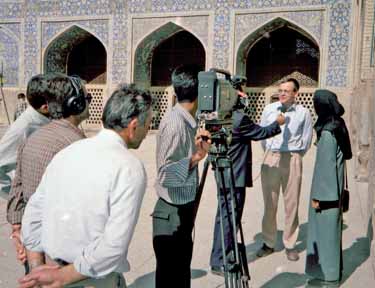
A few minutes later we are accosted by some journalism students. After a few innocuous questions they asked if they could pose a political question. What do we think about the US "invasion" of Afghanistan? After fulsome praise of the hospitality of the Iranian people, we point out that in addition to harboring terrorists the Taliban oppressed women and their Shiite minority and reflected poorly on Islam. I think they are disappointed in our answers. They probably will get a poor grade in agitprop and will have to repeat the course.
Dinner is at a very nice restaurant. Prior to 9/11 it was so packed with tourists that locals could not be seated. That situation no longer obtains.
After three nights in Isfahan we fly back to Teheran in the next morning. I am sick of bread, tea, and jam for breakfast and desperately leaf through the phrasebook looking for the Farsi word for Froot Loops.
On my last day I decide to visit departed rulers new and old: the Shah's palace and Khomeini's mausoleum
The palace is part of a complex north of town. My cabdriver on the way up was so excited to have an American as a fare that at the red lights he had to tell all his fellow cabbies.
The official residence of the former Shah, now called the National Palace, is fairly small in size. The decor is pretty tacky, but not quite up to Graceland standards as a monument to kitsch. There are VERY nice carpets, some as big as 150 sq. yds. We are talking about single piece made up of millions of hand-tied knots, not sewn together broadloom.
Nearby is the palace where the first Pahlavi, the Shah's father who seized power in a coup in 1928, lived. In the bad taste department, this one is much better. Mirrored tiles cover the walls and the ceilings. This one also has gorgeous rugs, atop which sits bordello-style furniture. The old shah, a soldier by trade, slept on the floor of his royal bed chamber. There is only one bathroom.
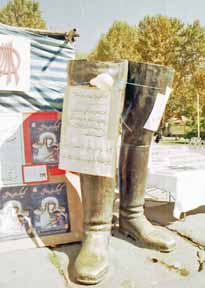 | 
|
In front are a pair of gargantuan bronze boots, all that remains of his statue -- quite literally "cut off at the knees."
The other visitors are mostly school groups. I can just imagine what they are being told: "Before the revolution this is where the wicked king lived He and his family ate all the food in Iran while the people starved." The problem for the current government is that fewer and fewer people look upon those times as the bad old days.
An old guy in a jaunty cloth cap comes up. "Where are you from?" he asks. "America? I was just there. I didn't see you." He has lived in San Jose since 1976, is now retired, and is back visiting relatives. He has never seen the palaces as they have only recently been opened to the public. While it cost me $7.50 to see two of the palaces, he paid 12? for all eight. Running into him was mutually beneficial: he got a free ride back and I got a cab for the day at the non-gringo rate.
The cabbie spoke some English and, he said, much better Japanese. As the day unfolded so did his tale of woe and intrigue. He had gotten a job at the Japanese Embassy in Teheran where he picked up some of the language and plotted his escape. When the job ended, he got a passport and went to Dubai. Then to Sharjah, then Qatar, then Bahrain, where he caught a flight to Hong Kong and thence to Tokyo. Once there, he had a passport full of stamps to prove his bona fides as a tourist so was granted a three-month visa. He quickly found work as a motorcycle mechanic earning $120 a day, more than he made in a month in Iran. Four years later, he got caught and was deported. Unfortunately, he had nothing to show for it, having spent it all on wine, women, and song. Now married with kids, he works as a cabdriver because he can't afford to buy a shop and, as an employee, wages are a pittance. He parks in front of the palace hoping to meet Japanese visitors.
The mausoleum is about 30 miles south of Teheran. (The Imam Khomeini International Airport currently until construction is even further out.) As we approach the array of domes and minarets looks like Disneyland. Actually, more like Khomeini Land. (The cabdriver got a kick out of that one.) It is enormous: the size of an airport terminal. On holidays, I hear, it is full.
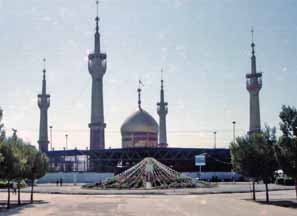 | 
|
There are no signs in English, but the hospitable reception continues. The guy at the shoe check gives me a big smile. The hand baggage inspectors are mystified by my GPS receiver until I turned it on and pantomimed its use. They conclude that it is a satellite device for locating Mecca (it'll do that, too) and are thrilled. Outside on the lawn, a family invites me to join them in their picnic lunch.
The mausoleum was sited near the main war cemetery. In these low-key, moderate days, the fountain no longer gurgles with blood red water, although there still is a captured Iraqi tank at the entrance and a blown up ambulance at the traffic circle.
My driver's 18-year-old brother is buried here, so we stop by his grave. He is one of six children, which is normal for Iran. After the revolution and during the war, the government needed cannon fodder so birth control ended. In the 21 years since the population has doubled, and family planning is back. The country is now reaping the whirlwind as 800,000 youth enter the job market each year.
There is a crowd at one building. It's Thursday is free lunch day. Besides an ad hoc mess hall, the building contains another grisly exhibition of battlefield casualties and blown up bodies in glorious color.
There are also souvenir shops. I look for Khomeini keychains, but there are only Khameni keychains. Wrong Ayatollah. I select a Khomeini poster, but the guy insists on giving it to me as a gift. Also for sale are numerous posters of bullet ridden bodies. One woman has a whole set of casualty photos she wants me to look through.
One building contains the graves of victims of numerous government officials killed when a bomb exploded in parliament. The incident is unabashedly described as a terrorist attack. They have a fine sense of definition: bomb throwers you support are "freedom fighters"; those you oppose are "terrorists."
Back in the city, I stop by an internet cafe, which exist only because there is no official licensing and taxation category for them. Internet access is unrestricted, allowing a complete circumvention of the government monopoly on information. There, I meet a guy who is about to emigrate to Canada. It has been a 4 and l/2 year process, but he has his visa and will be departing with his wife and son in 17 days. His English is flawless. He is a veterinarian currently employed as an inspector in a slaughterhouse. Ali invites me to his house where I meet his father, a retired judge, and his sister, who has a degree in English literature. As you might expect, an immigration visa to Canada is a dream come true, although he is concerned that in the current political climate they may encounter prejudice in Toronto. I advise him to lose the beard.
On the way back, the cab driver hears us speaking English. The driver has lost his office job and is driving his personal car as a cab to make ends meet. He asks my host my nationality, then conveys a message: "Tell him we are fed up with the situation. Tell him we want the Americans to come back."
The next day is Friday, the Muslim holy day. The streets are finally quiet and uncongested. At the airport check-in area is a large illuminated sign with a quote from Ayatollah Khomeini: "Palestine is the first international issue." Just in case we haven't gotten the message. Nonetheless, as one approaches the gate you can almost sense the control slipping. At the customs desk the guy asks "customs papers?" I shrug my shoulders, and he waves me on. In the departure lounge, the scarves are starting to slide back. The airport shop displays rugs officially forbidden to be exported: depicting women in un-Islamic dress and with their hair showing. On board the plane, as soon as the cabin door is shut the head scarves come off entirely. Once airborne the video screens drop down. The first program is the BBC news and a war report from Afghanistan. Everybody pays rapt attention. When the beverage cart comes by, never mind that it is 10 AM, it's wine, beer, and booze all around. Khomeini is in his grave and that's where they want him to stay.
EPILOGUE
Brussels-- The immigration officer asks me where I have been, then inquires about "the situation there." I have an overnight layover, so decide to leave my luggage at the airport. There are coin lockers, but they only accept coins, no notes or credit cards. I have just gotten some money from the ATM, but the smallest note dispensed is 1000 Francs. Change? Fuhgeddaboudit! All the shops have "no change" signs. The money exchange counter isn't staffed. I buy a train ticket, but the guy won't give me any coins in my change (you only need one coin to activate the lockers). FRENCH ASSHOLES! Finally, a nice, FLEMISH girl at the information booth fishes out some coins from her wallet.
At the hotel counter offering "discounts," their idea of a bargain is the Sheraton for $150. The cheapest room they find is $80. I take the train into the city. In the station, there is another accommodations kiosk. The best they can do is $60. I tell I her am looking for a deal. She points me to a hotel one block from the Grand Plaza, where I find a perfectly acceptable room with en suite for $40.
The terrorist attacks were supposed to bring a collapse of tourism. Here in the heart of Euroland, no such thing. The cafes are full of eurocrats sipping their lattes, and the marble steps are rife with bums enjoying their vin ordinairs. One can cross the street after merely looking out for traffic and assuming that oncoming cars will stay in their lanes and obey the traffic signals. Posters advertise a concert featuring Petula Clark, The Boxtops, Mungo Jerry, and Gilbert O'Sullivan. (Quiz answers: Downtown; The Letter; In The Summertime; and Alone Again (Naturally).) If washed-up pop stars and one hit wonders can't draw an audience in Brussels, they are starved for entertainment in Teheran.
Trip date: September-October 2001
